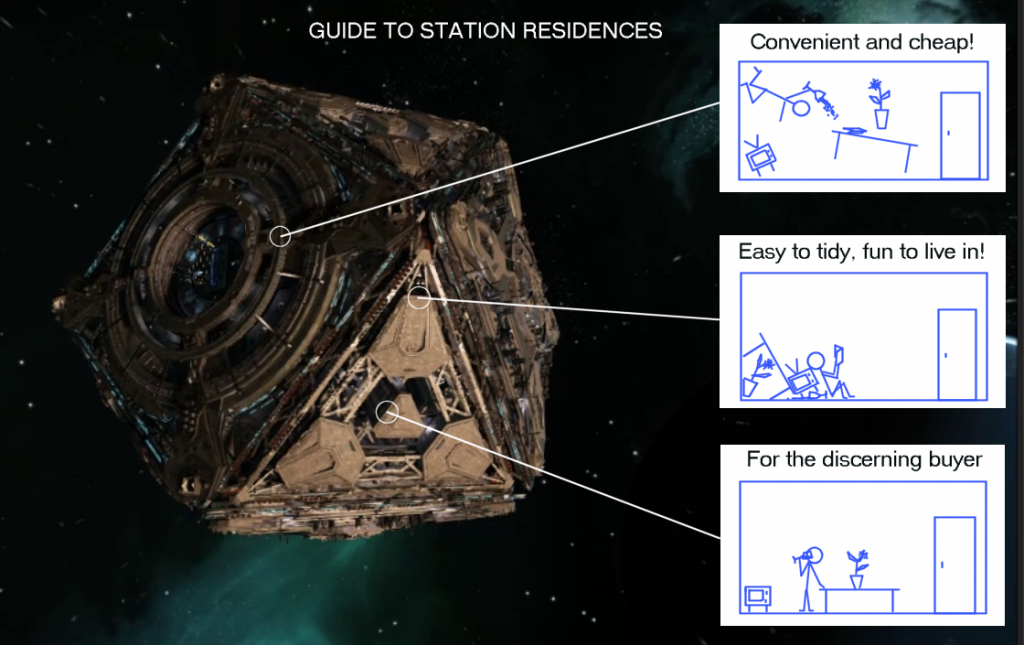So while doing a bit of flight assist off along the training station, I noticed gravity isn't ideal everywhere with this design.
youtube.com/watch?v=Pa4PhbHqZNs
youtube.com/watch?v=Pa4PhbHqZNs
its centrifugal force
that doesnt change the fact that the force is pulled outwarts in a straight line.Technically speaking, its centripetal force.
The artificial gravity works as long as you have the same angular momentum as the station, it's the same as jumping off a cliff, relatively speaking. So the direction you see me falling is the direction of the artificial gravity.
That effect only comes into play much further out, the square faces on the side of the station have correct gravity but the triangle corners do not.It doesn't exactly work like that. The station is rotating around a fixed axis. You are not bound to it so even if you keep your angular momentum fixed on the station actively , when you let go, you start drifting as the angular momentum gets translated into a linear momentum. In other words, it's like jumping of a 'moving' cliff into free fall. So your trajectory relative to the cliff surface would not be a straight line but curved.
You don't have to touch the structure. It's not glue or velcro. The gravity is accurately simulated in the game.its centrifugal force, everything touching the structuur is pulled outwarts.
not somewhat sidewarts like you showwed.
Nope, that's just inertia.that doesnt change the fact that the force is pulled outwarts in a straight line.
Deggial, I don't think you understand how artificial gravity works. The gravity comes from the fact that you are moving at the same speed as the station, but the station wall is curving up and away as it rotates while you don't. That different makes you fall down, or out rather. Because of maths I can't remember right now the effect is exactly the same as with real gravity, you will land in the same spot as you jumped from if you jump straight up. No atmosphere is required, no contact is required, I simply used my thrusters to give myself the same speed as the station walls.
Actually, the square faces only have correct gravity in their center as well, because the gravity effect is cylindrical out from the axis of rotation while those faces are flat.
Not normal, but tangent.If you place yourself outside a station, rotate with it for a while and then let go, you'll start flying out in a straight line connecting you to the central axis of the station. And you'll continue in this straight line until some other force acts on you. The station though, being constantly rotating will cause the spot you just left on the wall to drift away from you on an arc to which your trajectory vector is a normal.

Something I whipped up a long time ago, with my extraordinarily sophisticated artistic skills...
http://i766.photobucket.com/albums/xx310/CaptainKremmenED/coriolis2_zpsc8659550.png

But what, if you would have been inside the station and wouldn't have used your thrusters in order to allign tho the station's rotation? Without an atmosphere, you could happily drift for hours over a perpetually rotating "ground" (= the station walls).
But with an atmosphere filling the station, the gas would accelerate you, dragging you with it into its own rotation. You would "magically" fall towards the station walls without the need of any action of your own.
Nice, but it needs a small fix:
http://i.imgur.com/uTzM9bM.jpg
You fall directly outward, not in a tangent. That is the point of artificial gravity, if you didn't you have the situation in the middle pic above everywhere. The problem is that the triangle faces are not facing directly outward from the axis of rotation but at an angle. Do you see?
Your lines are wobbly and all over the place.
My lines were pretty, and straight.
You fall directly outward, not in a tangent.
The problem is that the triangle faces are not facing directly outward from the axis of rotation but at an angle. Do you see?
